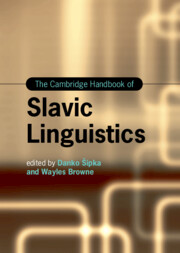972 results
Chapter 22 - Morphology
- from Part IV - Philosophy and Science
-
-
- Book:
- Goethe in Context
- Published online:
- 16 May 2024
- Print publication:
- 23 May 2024, pp 216-224
-
- Chapter
- Export citation
Introduction
-
-
- Book:
- The Cambridge Handbook of Slavic Linguistics
- Published online:
- 16 May 2024
- Print publication:
- 23 May 2024, pp 1-6
-
- Chapter
- Export citation
22 - Morphosyntactic Reflexes of Information Structure
- from Part 3 - Syntax
-
-
- Book:
- The Cambridge Handbook of Slavic Linguistics
- Published online:
- 16 May 2024
- Print publication:
- 23 May 2024, pp 477-498
-
- Chapter
- Export citation
9 - Tense and Mood Forms
- from Part 2 - Inflectional and Derivational Morphology
-
-
- Book:
- The Cambridge Handbook of Slavic Linguistics
- Published online:
- 16 May 2024
- Print publication:
- 23 May 2024, pp 179-210
-
- Chapter
- Export citation

The Cambridge Handbook of Slavic Linguistics
-
- Published online:
- 16 May 2024
- Print publication:
- 23 May 2024
The aesthetics of robot design: towards a classification of morphologies
-
- Journal:
- Proceedings of the Design Society / Volume 4 / May 2024
- Published online by Cambridge University Press:
- 16 May 2024, pp. 2413-2422
-
- Article
-
- You have access
- Open access
- Export citation
A new ring nematode, Xenocriconemella costaricense sp. nov., (Nematoda: Criconematidae) from Costa Rica
-
- Journal:
- Journal of Helminthology / Volume 98 / 2024
- Published online by Cambridge University Press:
- 10 May 2024, e39
-
- Article
-
- You have access
- Open access
- HTML
- Export citation
Development of derivational morphological knowledge in monolingual and bilingual children: Effects of modality and lexicality
-
- Journal:
- Journal of Child Language , First View
- Published online by Cambridge University Press:
- 07 May 2024, pp. 1-26
-
- Article
-
- You have access
- Open access
- HTML
- Export citation
Small micro- and nanoplastic test and reference materials for research: Current status and future needs
-
- Journal:
- Cambridge Prisms: Plastics / Volume 2 / 2024
- Published online by Cambridge University Press:
- 07 May 2024, e13
-
- Article
-
- You have access
- Open access
- HTML
- Export citation
Two new species of the genus Sectonema Thorne, 1930 (Nematoda, Dorylaimida, Aporcelaimidae) from Iran, with new insights into its evolutionary relationships
-
- Journal:
- Journal of Helminthology / Volume 98 / 2024
- Published online by Cambridge University Press:
- 15 April 2024, e32
-
- Article
-
- You have access
- Open access
- HTML
- Export citation
Gymnocranius indicus, a new large-eye seabream from the Indian Ocean
-
- Journal:
- Journal of the Marine Biological Association of the United Kingdom / Volume 104 / 2024
- Published online by Cambridge University Press:
- 04 April 2024, e38
-
- Article
- Export citation
Growth Conditions and Genesis of Spherical and Platy Kaolinite
-
- Journal:
- Clays and Clay Minerals / Volume 33 / Issue 3 / June 1985
- Published online by Cambridge University Press:
- 02 April 2024, pp. 200-206
-
- Article
- Export citation
Anauxite Viewed By Scanning Electron Microscopy
-
- Journal:
- Clays and Clay Minerals / Volume 30 / Issue 5 / October 1982
- Published online by Cambridge University Press:
- 02 April 2024, pp. 391-393
-
- Article
- Export citation
Mineralogical and Morphological Evidence for the Formation of Illite at the Expense of Illite/Smectite
-
- Journal:
- Clays and Clay Minerals / Volume 33 / Issue 4 / August 1985
- Published online by Cambridge University Press:
- 02 April 2024, pp. 265-274
-
- Article
- Export citation
Acid Dissolution of Akaganiéite and Lepidocrocite: The Effect on Crystal Morphology
-
- Journal:
- Clays and Clay Minerals / Volume 36 / Issue 5 / October 1988
- Published online by Cambridge University Press:
- 02 April 2024, pp. 385-390
-
- Article
- Export citation
Thermal Transformation of Talc as Studied by Electron-Optical Methods
-
- Journal:
- Clays and Clay Minerals / Volume 36 / Issue 4 / August 1988
- Published online by Cambridge University Press:
- 02 April 2024, pp. 289-296
-
- Article
- Export citation
The Nascence of Clay Minerals
-
- Journal:
- Clays and Clay Minerals / Volume 33 / Issue 3 / June 1985
- Published online by Cambridge University Press:
- 02 April 2024, pp. 161-172
-
- Article
- Export citation
Small-Angle X-Ray Powder Diffraction, Morphology, and Structure of Allophane and Imogolite
-
- Journal:
- Clays and Clay Minerals / Volume 33 / Issue 3 / June 1985
- Published online by Cambridge University Press:
- 02 April 2024, pp. 237-243
-
- Article
- Export citation
Authigenic Kaolinite and Dickite Associated with Metal Sulfides—Probable Indicators of a Regional Thermal Event
-
- Journal:
- Clays and Clay Minerals / Volume 36 / Issue 2 / April 1988
- Published online by Cambridge University Press:
- 02 April 2024, pp. 153-158
-
- Article
- Export citation
Botryoidal Goethite: a Transmission Electron Microscope Study
-
- Journal:
- Clays and Clay Minerals / Volume 31 / Issue 5 / October 1983
- Published online by Cambridge University Press:
- 02 April 2024, pp. 392-396
-
- Article
- Export citation



